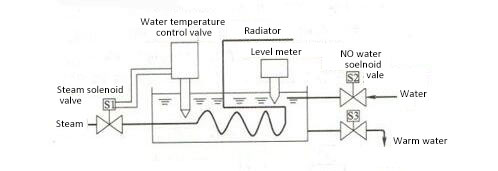Category

Solenoid Valve Supplier
Home » Application » Solenoid Valve for Temperature/Water Level/Pressure Control
Solenoid Valve for Temperature/Water Level/Pressure Control
As a small basic component in the automation field, solenoid valve is mainly switch on and shut off the pipeline with the power on and off. With its simple function, the solenoid valve is widely used to control on-off water, air, oil, gas and other media in various areas. There are some practical applications of solenoid valves.
Solenoid valve for temperature/water level control
Solenoid valves can be used to control temperature and water level. As seen in the Figure below, when the temperature of the water tank is lower than the control temperature, the contact point of the temperature detecting element is connected, so that the steam solenoid valve S1 is opened. The steam pass through for the heat exchange to make the water temperature rise to the control point temperature, and the steam solenoid valve can be closed.
The temperature solenoid valve S3 can be used at any time (such as shower, etc.).
 When the liquid level of the water tank is higher than the control point, the electrical contacts of the contact liquid level meter are closed, so that the normally-opened water solenoid valve S2 is closed. When the liquid level drops, the electrical contacts are released, so that the normally-opened water solenoid valve is open due to the power off, and the water enters the tank to replenish the water level.
When the liquid level of the water tank is higher than the control point, the electrical contacts of the contact liquid level meter are closed, so that the normally-opened water solenoid valve S2 is closed. When the liquid level drops, the electrical contacts are released, so that the normally-opened water solenoid valve is open due to the power off, and the water enters the tank to replenish the water level.
Solenoid valve for pressure level control
The solenoid valve is used to control pressure. When the pressure in the tank reaches the rated value, the electric contact pressure gauge or pressure switch is disconnected, and the solenoid valve is closed after power off. When the pressure in the tank is low, the electric contact is connected, and the solenoid valve is opened after power on. The pressure of the water or gas source is supplemented until it reaches the rated value.

Solenoid valve for temperature/water level control
Solenoid valves can be used to control temperature and water level. As seen in the Figure below, when the temperature of the water tank is lower than the control temperature, the contact point of the temperature detecting element is connected, so that the steam solenoid valve S1 is opened. The steam pass through for the heat exchange to make the water temperature rise to the control point temperature, and the steam solenoid valve can be closed.
The temperature solenoid valve S3 can be used at any time (such as shower, etc.).

Solenoid valve for pressure level control
The solenoid valve is used to control pressure. When the pressure in the tank reaches the rated value, the electric contact pressure gauge or pressure switch is disconnected, and the solenoid valve is closed after power off. When the pressure in the tank is low, the electric contact is connected, and the solenoid valve is opened after power on. The pressure of the water or gas source is supplemented until it reaches the rated value.

Solenoid valve for dust removal pipeline control
Dust removal pipeline is controlled by solenoid valve. When the dust exceeds the standard, the alarm is connected to the power supply. The solenoid valve is opened after power is switched on. The main pipe road is filled with water, and the small pipes are spray to remove dust. When there is no dust, the alarm is powered off and the solenoid valve is automatically closed.

Dust removal pipeline is controlled by solenoid valve. When the dust exceeds the standard, the alarm is connected to the power supply. The solenoid valve is opened after power is switched on. The main pipe road is filled with water, and the small pipes are spray to remove dust. When there is no dust, the alarm is powered off and the solenoid valve is automatically closed.

Post a Comment:
You may also like:

